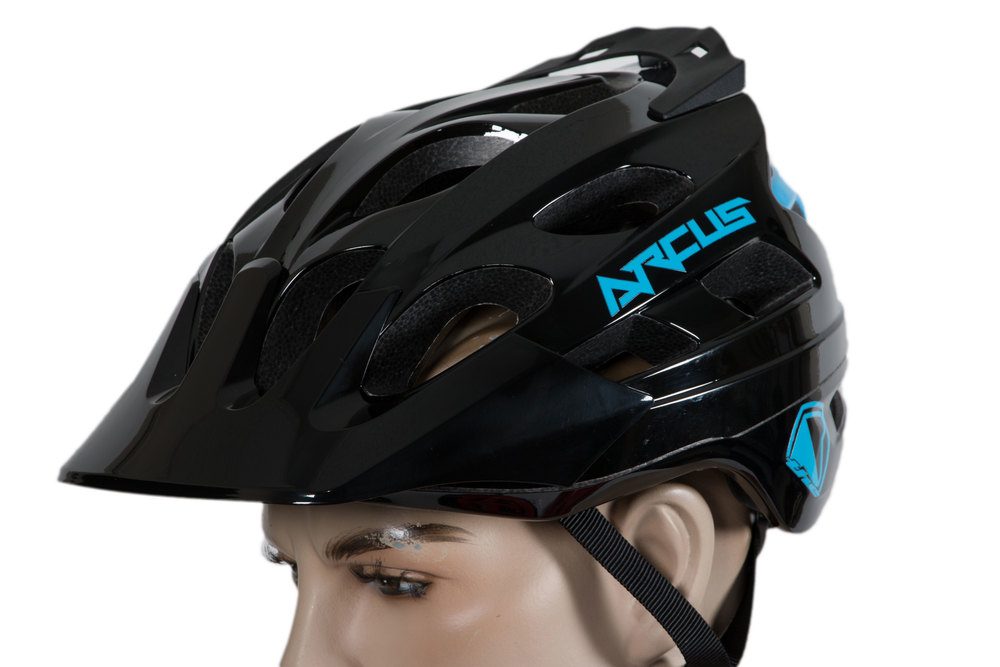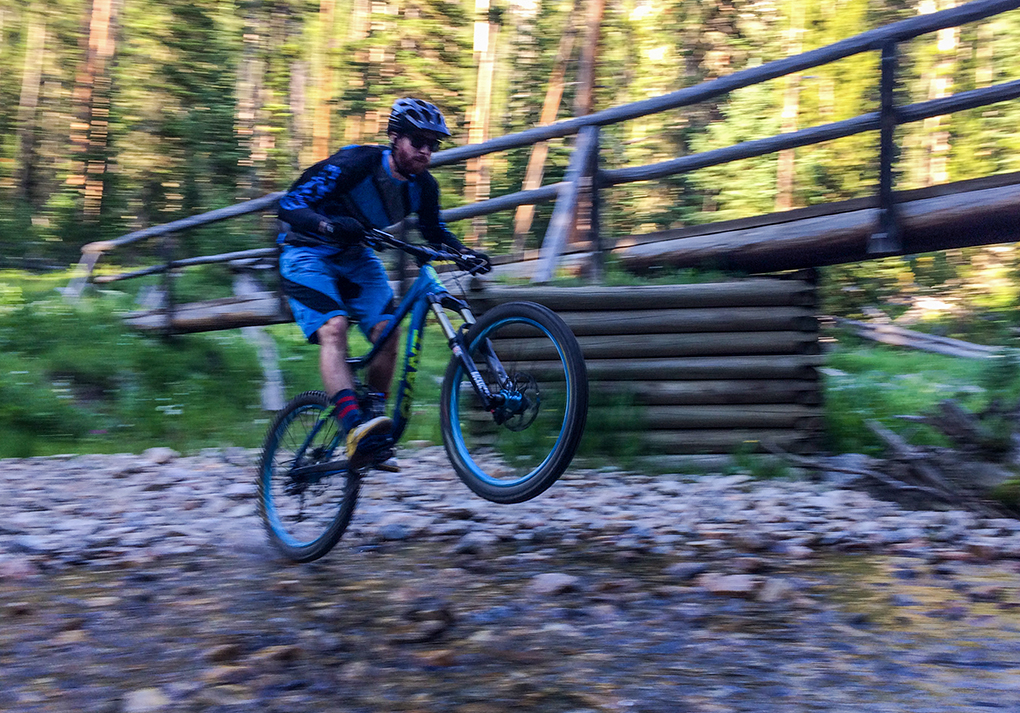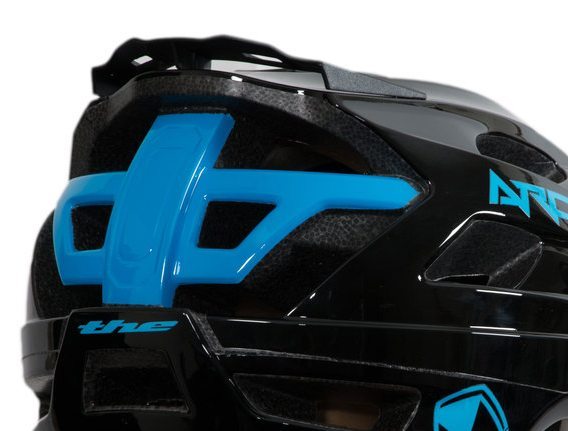
THE Industries Arcus Half Shell Helmet
Size: L/XL (58-62cm)
Color: Blue/Black
Blister’s Measured Weight: 347 grams
Reviewer: 6’0 170 lbs, Head circumference: 59 cm
Features:
- 23 Vents
- Dial size adjust
- CPSC/CE, EN 1078, AS/NZ 2063 Certified
MSRP: $49.99
Test Duration: 2 weeks
Test Location: Bozeman & Big Sky, Montana
With the advent of Enduro, the mountain biking world has seen an influx of products designed to increase protection for riding rowdy terrain without adding significant weight.
Unfortunately, this has come at a pretty steep cost, with “enduro specific” components often carrying a hefty price tag.
That’s why, when I was looking for a new trail helmet, the $49.99 THE Industries Arcus caught my eye. Its increased coverage and modern styling looked appropriate for more aggressive riding, and the low price was especially attractive in a market full of similar helmets priced between $70 – $150.
A Note on the ‘THE’ Name
“THE” used to stand for Toby Henderson Enterprises. When Toby left the company, VSI Products, the parent company shifted the name to The Hardcore Enthusiast. That’s a great acronym, but unfortunately it makes for a lot of confusion. (E.g., “Who makes that helmet?” “THE” “The who?”) It also makes googling any information about the company or products reasonably difficult…
Fit & Fit Adjustment
Helmet fit is incredibly important. All the fancy technology in the world isn’t going to save you if your brain bucket is rattling around on your head.
I have a more oval than circular shaped head, and the Arcus fits me well. The Arcus feels a touch more round than the Giro Feature MIPS, but not as circular as the Bell Super.

The Arcus uses a dial fit adjustment system like most other helmet manufacturers. It seems a little flimsy, but it has held up well so far. The dial is big enough that it’s easy to adjust on the fly, but not so big to be clunky or intrusive.
Initially, I found the adjustment to be a little confusing. The dial emits audible clicks while tightening, but not while loosening, so be aware of that: your helmet isn’t broken, it’s just that you only get the clicks when tightening the lid.
My head circumference is 59 centimeters when my hair is short. This meant that I could probably squeeze into the size S/M (54-58cm) Arcus, but with any hair growth things could get tight so I opted for the L/XL (58-62cm).
In the L/XL, I’m close to the small end of the helmet’s adjustment range. However the rear dial system does a great job of keeping the helmet secure without creating any pressure points or discomfort.
The straps stay flat and unobtrusive, and they are easy to adjust.
Another heads up: a single strap runs through the dial adjust and down as the rear strap on each side. If the helmet is hung by one side of the strap for an extended period of time, all the slack will migrate to that side and make the chin strap lopsided. This isn’t a big deal at all, it’s just important to remember to adjust before you ride if you hike with the helmet hanging off your bars.
Construction / Safety
The Arcus offers slightly less coverage than a skate-style helmet, but is much lighter and vents much better.
Since most of my worst crashes have involved whiplash impacts to the back of the head, rear protection is a priority for me, and the Arcus has thick ribs of foam across the back that should help cushion impacts there.

I haven’t yet taken a big crash in the Arcus, but the Arcus does meet all the same safety standards (CPSC/CE, EN 1078, AS/NZ 2063) as any other—often more expensive—helmet on the market. So until manufacturers begin to more specifically quantify helmet protection, I can only assume that it will do an equivalently adequate job of keeping me out of a vegetative state.
Venting
The Arcus vents reasonably well, with 14 large intake vents and 9 exhaust vents in the rear.
While these do a good job of letting air on to your scalp and allowing sweat to evaporate they don’t create as much noticeable airflow over the head as I expected. It seems that something about the shape of the vents and channels means that while air is moved over my head and it does stays cool, I don’t really feel the wind rushing over my scalp. It’s not XC-lid airy, but the Arcus does do a good job of letting my head cool.
In temperatures ranging from the low 60’s to the mid 90’s (Farenheit), my head never got intolerably hot or sweaty. It vents much better than the skate-style helmets I used to ride in, and the thin liner does a good job of wicking up sweat and keeping it out of my eyes.
By comparison, the Giro Hex helmet I rode in previously channeled air to cool my scalp a little better, but also allowed much more sweat to drip down into my eyes.
Other Features
The Arcus comes with a little plastic fin stuck to the top rear of the helmet. It reminds me of the spoiler some highschool kids stick on the back of their Honda Civics to make them look faster. I’m not sure if its purpose was to create downdraft and help with increased cornering precision or what, but I did not like it. Fortunately, it popped right off with three little connecting pins, and I threw it away. Fins are for Ferraris, not value-priced bike helmets.

Without the fin, the size L/XL Arcus weighs in at 347 grams. For reference, the Giro Feature ($75 without MIPS) weighs a stated 345 grams, while the TLD A1 ($139) comes in around 365 grams, and the Bell Super ($125) around 400 grams. That’s a very competitive weight for a $50 helmet with good rear coverage—especially given that those manufacturer-stated weights of the other helmets are probably for smaller sizes.
The visor on the Arcus is not very big, but it does provide some sun protection, and so far, has never interfered with my view. It is held on with four rather flimsy plastic pins and is not adjustable, so I wouldn’t be shocked if some of the pins fail in the future. But so far, so good.
If you’re the kind of Enduro Bro that likes to ride with goggles and a half shell, the Arcus probably isn’t the best choice, since it would be difficult to keep goggles up on the helmet and out of the way while climbing—there is not much room below the visor to prop up the goggles or run a strap.
The Arcus can hold sunglasses fairly well in its vents, and I have ridden with some generic Wayfarer-style shades like this. But I would not recommend doing this regularly (or with expensive sunglasses) since it’s not exceptionally secure.
Bottom Line
I’m going to be riding more with the Arcus, and I’ll update this review when I’ve got more time in it to see if it continues to hold up.
But so far, the THE Industries Arcus combines a good fit, increased coverage, adequate venting, and a low weight at a fraction of the price of its competitors. If you’re looking for the latest and greatest styling and technology, you should probably consider other (more expensive) options.
But if you just want to protect your brain without selling a kidney, the Arcus is a solid option that won’t break the bank if it does need to be replaced.
